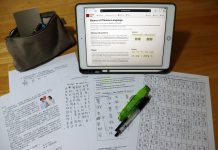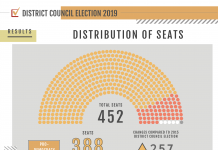Geocaching – all you need is courage, curiosity and a GPS device for you outdoor adventure.
Reporter: Carmen Shih
Feeling quite seasick after their journey to the remote island of Ng Fan Chau near Shek O, two young men eagerly jump off the boat as it approaches shore. They land on rocks and climb quickly into a tangle of bushes. The men look like characters in an action movie but, in fact, they are modern day treasure hunters taking part in geocaching (ge-o-cash-ing), a pastime that combines travel, hiking, navigating and exploring.
Geocaching is a worldwide treasure hunt using modern technology. With Global Positioning System (GPS) receivers or smartphones, participants look for hidden containers known as geocaches (or “caches”) whose coordinates are listed on geocaching websites. Every geocache contains a logsheet or logbook. Participants, who are known as geocachers, can write down how they got to the cache and share their feelings about it.
Geocaching uses technology to pull people away from their computers and into the great outdoors. “The most important part is the idea of finding an adventure at a location, the idea that you can go out and then you’ll find an adventure somewhere,” says Jen Sonstelie, the marketing manager for Groundspeak, the company that runs geocaching.com.
Currently, there are over 1.5 million active geocachers all over the world.
The game started on May 30, 2000. It quickly spread to different parts of the world — and even into space. The first traditional geocache in Hong Kong was hidden in January 2002 by Joan Garcia, a chemist from Spain. He hid the cache, named “Tram Peak”, inside the Lung Fu Shan Country Park, near the peak of High West.
“It is very important to choose a place you know others will enjoy, don’t just go with a box to a place you still do not know and try and find a place,” says Garcia, who chose the location because it has a view of both skyscrapers and dense vegetation.
Garcia was delighted that he hid the first cache in Hong Kong. “I try to imagine how other people will live the experience.” He even left a camera in the box for the geocachers to take a picture of themselves.
There are currently more than 400 active caches in Hong Kong and local geocachers have established a geocaching community with around 30 active members. Jimmy Tang Tai-kwan, one of the young men at Ng Fan Ch au, started geocaching in 2005. Tang, who is a software engineer, acquired a GPS chip through work. His research revealed that geocaching was one of its uses.
Although Tang grew up in Hong Kong, he says geocaching has allowed him to learn more about the place. His most memorable cache in Hong Kong so far is the “Pillbox” at Wong Nai Chung Gap. A pillbox is a type of military bunker and the pillboxes at Wong Nai Chung Gap date from World War Two.
“Climbing into the water tunnel was the only way that I could reach the cache. It was steep but not very dangerous. I estimate the risk before I take action,” says Tang.
The search itself was rewarding because it led him to the best preserved pillbox in Hong Kong. The cache is owned by a geocacher who loves WWII relics.
Owners often inject their personality into the ways they design and hide their caches, which can look very different from one another. Caches come in different sizes and shapes, ranging from a tiny magnetic container to a cargo container. In urban areas, caches are usually in smaller containers so they are easier to hide. In the countryside, caches tend to be bigger and contain more contents. They are usually lunch boxes or DIY containers.
Apart from a logbook or logsheet for geocachers to record their visits and feelings, larger caches might contain any number of valuable and not so valuable items such as figures, coins and stamps. These items turn geocaching into a real treasure hunt as a geocacher never knows what the owner or other visitors to the cache may have left there for the next person to enjoy.
Quite often, geocachers may also find a “Trackable”. A Trackable has to move from one geocache to another. Sometimes Trackables may have special requests, for example “I want to jump to Japan!” Each Trackable has a unique code the finder can use to log its travels online.
Arius Saniel, a geocacher from the Philippines who works as a hardware engineer for Oracle in Shenzhen, makes all his caches magnetic. His containers are usually small and well-camouflaged, with a log sheet inside.
King Lee Wan-wai, the other young man from the Ng Fan Chau trip is also a member of the local geocaching community. He first came across the term online in 2007 and did some research into it, and “discovered a hidden world parallel to ours”. Lee tried it using a GPS phone and found his first geocache in Melbourne.
He has been hooked ever since.
Engaging in geocaching while travelling is a good way to visit interesting places that are not found in travel books. “It helps me see more of a place or country and get to share them with friends during group hunts,” says Lee.
Lee’s tally so far is 665 finds in 16 countries. One of the most memorable finds was in Rome, where geocaches are hidden in famous places of interest like the Colosseum and the Vatican City. One of the caches is a copy of the famous “Mouth of Truth” carving which is supposed to bite off the hand of those who are not telling the truth. Lee still has both his hands.
Lee loves geocaching so much that he is willing to share his experience with beginners and receives overseas geocachers. “It brings me to places, to see through the eyes of the cache owner and what he was trying to show us, [and I] meet new people from all walks of life,” he says.
Lee also finds that one of geocaching’s rewards is personal growth. “I think geocaching can develop a person’s senses and patience,” he says. “I had a friend who went searching for the same cache 15 times and finally found it. The challenge made him grow in persistence and determination.” He adds that guts, the capacity to think like a detective and the ability to make social contacts are also important aspects of geocaching.
Geocachers often refer to non-geocachers as “Muggles” after the characters without any magical ability in the Harry Potter series. The term is usually used to describe a non-geocacher who looks puzzled after coming across a geocacher searching for a cache, or when a non-geocacher accidentally finds a cache.
Even though geomuggles are mostly harmless, it is the responsibility of geocachers to make sure muggles do not see them with the cache. Otherwise, the cache will be at risk of disappearing.
To be a responsible geocacher, players must follow the guidelines listed on geocaching.com and respect the environment. “Cache in, trash out” means geocachers should pick up the rubbish at “ground zero” and help keep the place clean for the next player to enjoy. “A cache owner should bring people to interesting places but [a cache] should not be on private property, or in a police station or any dangerous place,” says Arius Saniel.
Dave Robinson, who lives in Thailand, often goes geocaching with his family. He has already found most of the caches around his neighbourhood. When Varsity met him, Robinson, who works as a flight attendant for Delta Airlines, was on his first day to stop-over in Hong Kong.
Being a flight attendant, he has been able to visit geocaches in different countries. Among the caches in Hong Kong, he recommends the view from “I LOVE HONG KONG”, a cache hidden at Ocean Terminal.
GPS signals become jumpy between buildings and the caches in Hong Kong tend to be tiny. The solution to the challenge is to read the logs beforehand and plan thoughtfully. A map and a compass are recommended for country park hunting.
Sometimes it is especially hard for a foreigner to be walking around, looking up and down in every corner at a ground zero location. Most security guards will be suspicious and muggles are curious.
With the widespread use of smartphones and hi-tech products in Hong Kong, more young people are able to participate in the game. Geocachers in Hong Kong can expect the distribution of caches to be localised because new players tend to hide caches near where they live.
Paul Wong Kwan and Xenia Wong Yuen-ting are second-year students from the University of Hong Kong. They started geocaching three months ago and are part of a younger generation of geocachers.
“Even though you can’t take away the treasure at the end, you can learn more about the place you live in,” says Xenia.
She got a special view of Victoria Harbour from the top of the China Hong Kong City complex when she was looking for the “Golden Gateway” cache in Tsim Sha Tsui. Another favourite spot is the street opposite the Polytechnic University of Hong Kong. Xenia found food stalls there with well-prepared and delicious snacks, a treasure of another kind which would have remained undiscovered but for a cache search.
But while Xenia and Paul are enthusiastic about their newfound hobby, they have had a tough time getting their peers to join in. Paul says he tried to introduce geocaching to his friends but few have shown any interest. He guesses it may be because they cannot afford a GPS; and even if they had one, Hong Kong people prefer shopping to hiking.
Still, if you happen to have a smartphone and are prepared to step out of the mall, you might re-discover a sense of advenuture in your neighbourhood. “Geocaching will lead you to a place worth visiting,” says Xenia.











































